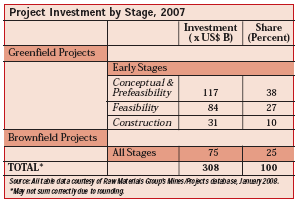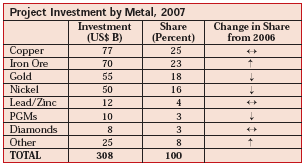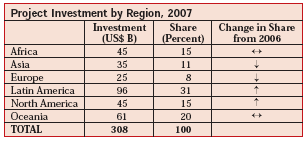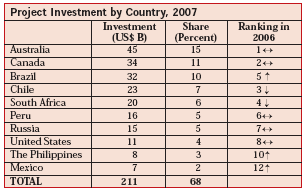
E&MJ’s Annual Survey of Global Mining Investment
The mining boom continues—but signs of a slowdown appeared in 2007
By Magnus Ericsson and Viktoriya Larsson, Raw Materials Group

Project capital cost estimates are updated throughout the year and with increasing demand for mining equipment, those costs are escalating quickly. However, we have also observed that projects are being expanded when moving from the feasibility to the construction phase and cost increases are thus not totally attributable to higher unit costs. During 2007, cost increases recorded for “old” projects—those first registered before the start of 2007—were of the same order of magnitude as newly registered projects, or about $50 billion when projects that have been completed during the year are also taken into account. This is partly due to increased costs for equipment but also to development of more complex ore bodies; deeper, lower grade deposits; and the increasingly remote locations of new mines. The demand for experienced staff has also turned out to be a bottleneck in areas such as Western Australia where investment activity is running in top gear and has been doing so for some time. All these observations together indicate a rising long-term cost level beneath the soaring metal prices.

Investment in brownfield projects totals $75 billion in this year’s database, up slightly in relative terms from last year. A project usually takes more than a year to realize (on average 12-18 months) depending on the location, available infrastructure, availability of financing and many other factors. The volume of projects in pre-feasibility stages has grown, indicating that there is still a steady flow of new projects into the pipeline. Our earlier prediction that there will be a continued growth in projects under construction at least in the next year seems to be correct but with the first signs of a slowdown in metal price increases—and with some prices actually dropping—we estimate growth in 2008 will be slower than in 2007.
All statistics are based on projects with a recorded projected investment. The RMD Metals Mines/Projects database also includes more than 1,900 projects for which no investment estimates are available. The database also includes 350 projects at the pre-feasibility and feasibility stages. The investment total for all mining projects, including those projects for which no investment estimate has been published, is much higher than $308 billion, but it is difficult to estimate how much higher. The total figure would probably reach well above $500 billion if it is assumed that projects without published investment estimates have a similar cost structure to projects whose costs are known. It could, however, also be argued that the remaining projects are less expensive, because most mega-projects are conducted by public companies that must disclose all important investment to the public. If this is the case, the total figure would be smaller.
Metals not covered in this report but included in the database, such as bauxite and some alloying metals, also require additional investment. Had they also been included, the total figure would increase further but probably by not more than $20 to $25 billion cumulatively at the mine stage.
The Big Four Grab 82%
Copper, iron ore, gold and nickel, respectively,
are the major investment targets for
mining companies. These four metals
account for 82% of the total project
pipeline. They also dominate the industry in
terms of the total value of its output, being
cumulatively valued at $235 billion or 63%
of the total value of all non-fuel minerals
production.


Gold and nickel’s respective shares of the total pipeline dropped, while copper remained at the same level as in 2006. The database’s “Other” category increased slightly, mostly from new uranium, molybdenum and other ferroalloys projects. Interest in PGMs fell, and lead/zinc’s portion of total proposed investment remained static after a strong increase in 2006.
Although the average cost of a gold project has risen to about $130 million, it is still much lower than the $345-millionplus average cost for copper projects. This is because it is still possible to find small, high-grade gold deposits that can be mined profitably by junior or mid-sized companies, while most new copper projects are often huge low-grade surface operations.
The average iron ore project is even costlier than a copper project, reaching well above $500 million. Nickel projects once were the largest of all types, with new laterite technologies being technically more demanding and the ore grades often low, necessitating haulage of large volumes of ore and waste, but iron ore projects are catching up fast. PGM project costs fall in between those of copper and gold projects, while zinc project costs are generally in the same range as gold projects.
When comparing average costs over the last couple of years, price increases become obvious: Gold project costs, for example, have almost doubled. But it also appears that this rapid rate of increase has slowed somewhat, as average prices for new projects did not increase significantly in 2007 when compared with the total average over all years.
Among the new projects listed in the database during 2007, iron ore dominates accounting for over 47% of the value of all new projects. Copper follows with 27%. Gold, at 7%, declined markedly from 17% in 2006. Nickel’s 8% is also half of its level in the previous year.
Latin America has been a focus for mining investors of the world for several years, and slightly less than a third of this year’s listed projects are located in Latin American countries. In 2007, Latin America’s share of project investment increased after two years of decline. Oceania, including Australia and Papua New Guinea, remains the second most important region with about 20% of the investment pipeline. Africa’s share remained static during 2007, while North America’s grew from 13% to 15% due mainly to an increase in projects in Canada. Asia’s share of investments dropped from 14% to 11% in spite of an absolute increase of $6 billion. Europe drew 8% of global investment, roughly the same level as last year.
Spreading the Dollars
In 2007, 10 nations attracted 61% of total
investments. This is a major reduction in
cumulative share from 2006, indicating
that mining investments are being spread
more evenly around the globe; simply, the
race for resources has been extended to
more countries than before. Australia, still
uncontested at the top with $45 billion in
its pipeline, remains the most attractive
country for mining investments ranging from
huge iron ore projects in Western Australia
to base metals and numerous gold projects
continent-wide. Canada remains in second
place increasing its share to 11%. Brazil is
third, having expanded its project pipeline
by over 100% due mainly to the giant iron
ore projects planned in several parts of the
country. Chile follows in fourth, down from
third in 2006 and second in 2005, with a
portfolio of $23 billion account representing
7% of total investment. South Africa fell to
fifth. Peru remained in sixth, further establishing
it as a stable, important mining
nation. Russia’s move up the list has ended,
with both its position and its share of total
investments remaining static in 2007 after
several years of growth, perhaps reflecting
increasing uncertainty about future control
over natural resources in the country.
Below the top-10 cutoff are New Caledonia, Argentina, DRC, Papua New Guinea, Mongolia, Madagascar, China and Kazakhstan, in that order, each with a portfolio of projects valued at between $3 billion and $7 billion. However, this range probably represents a sigificant under-estimate of mining investment in China.